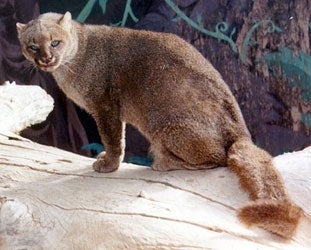SCIENTIFIC NAME:
Herpailurus yagouaroundi
OTHER NAMES:
Otter Cat
STATUS:
Accidental. Rare sightings reported from southwestern and central Alabama, but there is no evidence of a breeding population in Alabama or adjacent states. Listed as endangered by the U.S. Fish and Wildlife Service.
DESCRIPTION:
The jaguarundi is one of the smallest wild cats and is only slightly larger than a house cat. It stands about 1 to 2 feet tall and ranges from 19 to 30 inches from head to start of tail. The tail ranges from 12 to 24 inches in length. The overall length (head to tip of tail) is approximately 3 to 4 feet.
The long, low lying body of the jaguarundi gives it a weasel-like appearance. The head is small and flat with small, low lying ears that gives the jaguarundi the face of an otter, hence the name otter cat. It has two color phases that can be present in the same litter. The first one is the black to gray phase. This phase is more prevalent in populations that live in the rain forest. The second color phase is the red phase and it tends to be more prevalent in more arid climates.
DISTRIBUTION:
The jaguarundi is found in southern Texas and Arizona, south through Central America and Mexico into South America. There have been sightings in Florida which are thought to have been introduced populations as well as a few unconfirmed sightings in southern Alabama.
HABITAT:
This cat inhabits thickets that are nearly impenetrable to man or dogs. Areas of shrubby, thorny plants like mesquite and cactus are its preferred habitat. They also have been known to inhabit swamps and other thick forests. The presence of running water is a big preference.
FEEDING HABITS:
The jaguarundi is a carnivorous animal that hunts in the early morning and late evening hours. It preys upon small rodents like rats, mice, and rabbits. It will also jump into the air to catch low flying birds. Since it is a great swimmer, fish and frogs are a good portion of their diet as well. Stomach contents show fruits and other plant material as a small part of their diet.
LIFE HISTORY:
There is little known about jaguarundi reproduction. Females are in estrous for 3-5 days and show their receptivity by regularly rolling onto their back and spraying urine.
Once bred, the female will locate a natural den. This den maybe located in a hollow log, a cave, or in a brush pile. The female will have a gestation period of up to 70-75 days. At the end of her gestation, she will give birth to 1-4 deaf and blind kittens that will have lite spots. These spots will disappear in a few days. At about three weeks, the mother will start to bring little pieces of whole food to the young. However, the young will continue to nurse for a few more weeks. At approximately six weeks, the kitten will be completely weaned. It is unknown how long the kittens remain with their mothers.
References
Grzimek, B. 1975. Animal Life Encyclopedia. Van Nostrand Reinhold Company, New York, NY. 327-328.
Rick, J. 2004. "Puma yagouaroundi" (On-line), Animal Diversity Web. Accessed June 12, 2012 at https://animaldiversity.org/accounts/Puma_yagouaroundi/
/Puma_yagouaroundi.html
Whitaker Jr., J. O. 1995. National Audubon Society Field Guide to North American Mammals. Chanticleer Press, Inc. New York, NY. 601-602.
Author:
Griff Johnson, R.F., Wildlife Biologist, Alabama Wildlife and Freshwater Fisheries Division






